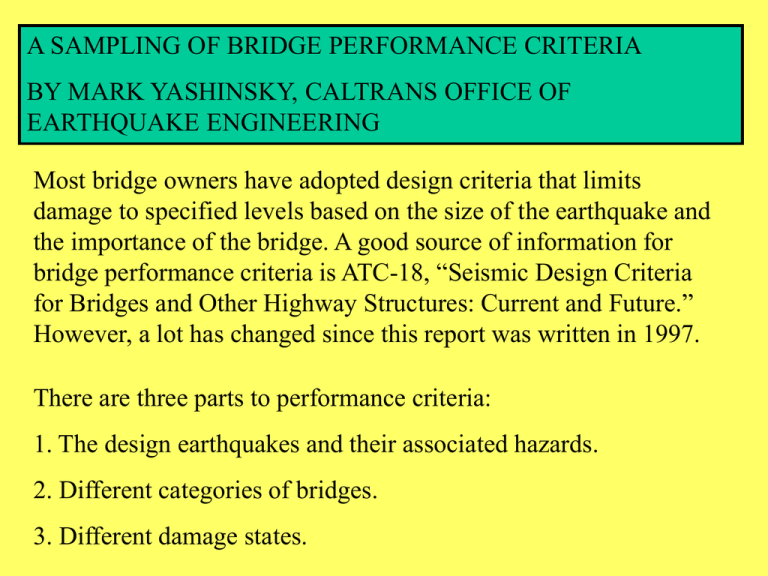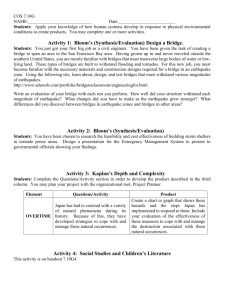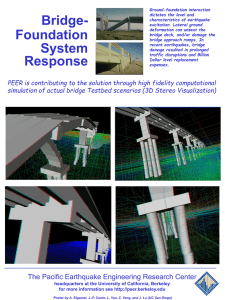Bridge DVs
advertisement

A SAMPLING OF BRIDGE PERFORMANCE CRITERIA BY MARK YASHINSKY, CALTRANS OFFICE OF EARTHQUAKE ENGINEERING Most bridge owners have adopted design criteria that limits damage to specified levels based on the size of the earthquake and the importance of the bridge. A good source of information for bridge performance criteria is ATC-18, “Seismic Design Criteria for Bridges and Other Highway Structures: Current and Future.” However, a lot has changed since this report was written in 1997. There are three parts to performance criteria: 1. The design earthquakes and their associated hazards. 2. Different categories of bridges. 3. Different damage states. I) The Design Earthquake. Japan’s Design Earthquake All bridges are designed for three levels of earthquakes. 1. A high probability/low intensity earthquake and two very large, low probability earthquakes. 2. a 1923 Tokyo subduction zone event 3. a 1995 Kobe crustal event. For smaller, more frequent events both ordinary and important bridges are to survive without damage. For larger, low probability events, ordinary bridges must survive without collapse and important bridges must have limited damage. New Zealand Design Earthquake All bridges are designed for three levels of earthquakes. 1. A design earthquake with a return period of 450 years. 2. A smaller earthquake adjusted using a Poisson Distribution. 3. A very rare earthquake adjusted using a Poisson Distribution. I) The Design Earthquake continued. AREMA (Railway) Bridge Design Earthquake Railway bridges are designed for three earthquakes Ground Motion Level 1 2 3 Frequency Occasionally Rare Very Rare Average Return Period (yrs) 50-100 200-500 1000-2400 Level 1 ground motion that has a reasonable chance of being exceeded during the life of the bridge. Level 2 ground motion that has a low probably of being exceeded during the life of the bridge. Level 3 ground motion for a rare, intense earthquake. The return period for each limit state is determined by multiplying the difference in the average return period in the table above by an importance classification factor ‘I’; dividing the product by 4; and adding the result to the minimum return period. Chapter 9 of the AREMA manual provide maps from the USGS that give the peak rock accelerations for 100 year, 475 year, and 2,400 year return period earthquakes for Canada, the United States, and for Mexico. Base acceleration coefficients (as a percentage of g) are taken from the 100 year, 475 year, and 2,400 year maps and linearly interpolated with the return periods obtained using the importance classification factor to obtain the acceleration for the three limit states. I) The Design Earthquake continued. AASHTO LRFD DESIGN EARTHQUAKE (2001) Probability of Exceedance for Design Earthquake Performance Level Life Safety Operational Rare Earthquake (MCE) 3% in 75 years Service Significant Immediate Damage Significant Minimal Frequent or Expected Earthquake 50% in 75 years Service Immediate Immediate Damage Minimal Minimal Design Earthquake The upper-level earthquake considered in these provisions is designated the Maximum Considered Earthquake, or MCE. In general the ground motions on national MCE ground motion maps have a probability of exceedance of approximately 3% in 75 years. However, adjacent to highly active faults, ground motions on MCE maps are bounded deterministically. When bounded deterministically, MCE ground motions have a probability of exceedance higher than 3% in 75 years. The performance objective for the frequent or expected earthquake is either explicitly included as an elastic design for the 50% in 75 year force level or results implicitly from design for the 3% in 75 year force level. Caltrans Design Earthquake Safety Evaluation Ground Motion (Up to two methods of defining ground motions) Deterministically assessed ground motions from the maximum earthquake as defined by the Division of Mines and Geology Open-File Report 92-1 (1992). Probabilistically assessed ground motions with a long return period (approx. 1000-2000 years). For important bridges, both methods shall be given consideration, however the probabilistic evaluation shall be reviewed by a CALTRANS approved consensus group. For ordinary bridges, the motions shall be based only on the deterministic evaluation. In the future, the role of the two methods for these bridges shall be reviewed by a CALTRANS approved consensus group. Functional Evaluation Ground Motion: Probabilistically assessed ground motions that have a 60% probability of not being exceeded during the useful life of the bridge. A CALTRANS approved consensus group shall review the determination of this event. Although the performance criteria provide functional evaluation requirements for ordinary bridges, these structures do not require an explicit functional evaluation if they meet the safety evaluation performance criteria. In other words, Caltrans designs ordinary bridges for only one event, the deterministically assessed ground motion from the maximum earthquake. I) The Design Earthquake concluded. Designing bridges for different return periods makes sense in regions where large earthquakes are rare. However, in California, there is only a moderate difference between the 100 year event and the 10000 year event as shown in the figure below. II) Bridge Categories. Japan’s Bridge Categories Bridges shall be classified into two groups of importance considered in relation with road classes and bridge functions and structures: Class A bridges are of ordinary importance. Class B bridges are of high importance. New Zealand’s Bridge Categories Bridges are divided into three categories based on traffic and importance (jurisdiction). Caltrans Bridge Categories After the Northridge Earthquake (Housner, 1994), Caltrans adopted performance criteria for important and ordinary bridges, where an important bridge meets one of three criteria: A bridge required for secondary life safety, such as providing the only access to a hospital. A bridge formally designated as critical by a local emergency plan. A bridge whose loss would cause a major economic impact. All other bridges are considered ordinary. AASHTO LRFD Bridge Categories Bridges are divided into three categories of importance, but these categories are not specifically addressed in design. II) Bridge Categories concluded. US RAILWAY (AREMA) Bridge Categories (2000). The Importance Classification Factor ‘I’ is the sum of a bridge’s immediate safety value, its immediate value, and its replacement value (all multiplied by different weighing factors). IMMEDIATE SAFETY VALUE (factors are summed and the total < 4). Occupancy Factor Freight Service only 1 Less than 10 passengers per day 2 More than 10 passengers per day 4 0 to 4 Hazardous Material Factor 0-4 Community Lifeline Factor IMMEDIATE VALUE (factors are summed) Railroad Utilization Factor Under 10 million gross tons annual traffic 1 Between 10 million to 50 million gross tons annual traffic 2 Over 50 million gross tons annual traffic 4 Detour Availability Factor No Detour Available 1.00 Inconvenient Detour Route 0.50 Detour Route Readily Available 0.25 REPLACEMENT VALUE (factors are summed and the total < 4) Span Length Factor Less than 35 ft 1 Between 35 and 125 ft 2 Between 125 and 250 ft 3 Greater than 250 ft 4 Bridge Length Factor Less than 100 ft 1.0 Between 100 and 1000 ft 1.5 Greater than 1000 ft 2.0 Bridge Height Factor Less than 20 ft 0.75 Between 20 and 40 ft 1.00 Greater than 40 ft 1.25 III) Damage. Japan’s Bridge Damage For smaller, more frequent events both ordinary and important bridges are to survive without damage. For larger, low probability events, ordinary bridges must survive without collapse and important bridges must have limited damage. Safety Factor a, for Reducing the Lateral Force on Concrete Piers. Bridge Importance Type Type I Ground Motion Type II Ground Motion Type B – Important Bridges 3.0 1.5 Type A – Standard Bridges 2.4 1.2 New Zealand Bridge Damage 1. After a design event, the bridge should remain usable for emergency traffic, although some repairs may be needed. Moreover, the bridge should be repairable to its initial condition. 2. After an event with a return period significantly smaller than the design value, damage should be minor, and without disrupting traffic. 3. For an event with a very large return period, the bridge should not collapse. Moreover, it should be usable to emergency traffic after temporary repairs and it should be capable of being brought back into service, perhaps at a lower level of service. AREMA (Railway) Bridge Damage The serviceability limit state provides for train safety after a moderate event. The ultimate limit state provides structural integrity after a large event. The survivability limit state prevents bridge collapse for intense events. III) Damage continued. Caltrans Performance Criteria for New Bridge Design. Ground Motion at Site Ordinary Bridge Important Bridge Functional Evaluation Ground Motion Functionality – Some Loss Functionality – Slight Loss Damage State – Moderate Damage State – Minor/Slight Safety Evaluation Ground Motion Functionality – Considerable Loss Functionality – Some Loss Damage State – Major/Extensive Damage State - Moderate AASHTO LRFD PERFORMANCE CRITERIA (2001) Probability of Exceedance for the Design Performance Level Life Safety Operational Earthquake Rare Earthquake (MCE) Service Significant Immediate 3% in 75 years Damage Significant Minimal Frequent or Expected Earthquake Service Immediate Immediate 50% in 75 years Damage Minimal Minimal Service Levels Immediate Full access to normal traffic shall be available to traffic following an inspection of the bridge. Significant Disruption Unlimited access (reduced lanes, light emergency traffic) may be possible after shoring, however the bridge may need to be replaced. Damage Levels None Evidence or movement but no notable damage. Minimal Some visible signs of damage. Minor inelastic response may occur, but post-earthquake damage is limited to narrow flexural cracking in concrete. Permanent deformations are not apparent, and any repairs could be made under non-emergency conditions with the exception of superstructure joints. Significant Although there is no collapse, permanent offsets may occur and damage consisting of cracking, reinforcement yield, and major spilling of concrete may require closure to repair. Partial or complete replacement of columns may be required in some cases. For sites with lateral flow due to liquefaction, significant Inelastic deformation is permitted in the piles, whereas for all other sites the foundations are capacity-protected and no damage is anticipated. Partial or complete replacement of the columns and piles may be necessary if significant lateral flow occurs. III) Damage continued. The FHWA Retrofit Manual uses damage criteria developed by Mander and Basoz in their “Seismic Fragility Curve Theory for Highway Bridges” to prioritize bridges for retrofit. Categories of Bridge Damage (Mander, 1999). Damage State 1) None (pre-yield) 2) Minor/Slight 3) Moderate 4) Major/Extensive 5) Complete/Collapse Functionality Required Repairs No Loss. None Slight Loss. Inspect, Adjust, Patch Some Loss. Repair Components Considerable loss. Rebuild Components Total loss. Rebuild Structure Expected Outage None < 3 days < 3 weeks <3 months >3 months It uses NBI fields to determine the bridge fragility. NBI Data 1 8 27 34 42 43 45 46 48 49 52 Definition State Structure number Year built Skew Service type Structure type Number of spans in main unit Number of approach spans Length of maximum span Structure Length Deck Width Other Use To infer type of code design General identification number Infer whether or not a seismic design To select only highway bridges Single or multi-span To infer base fragility curve To infer whether it’s a major bridge To infer if it’s a major bridge To infer span length and replacement value. To compute replacement value III) Damage continued. FHWA RETROFIT MANUAL EXPECTED DAMAGE METHOD FOR THE RANKING AND PRIORITIZATION OF BRIDGES This method compares the severity of damage to each bridge due to the same earthquake. The bridges are ranked by the amount of damage, RCRT or the total cost of repair, TLOSS. RCRT ( RCR i PDS i S a ) 1.0 5 i2 PDS i S a = probability of being in Damage state DSi for a given spectral acceleration Sa at structural period, T = 1.0 sec. RCR = repair cost ratio for ith damage mode Damage 1 none 2 slight 3 moderate 4. extensive 5 collapse RCR 2 1.0 # spans RCR 0 0.01 to 0.03 0.02 to 0.15 0.10 to 0.40 TLOSS = BLOSS +HLOSS Where BLOSS =cost of structural damage and HLOSS =indirect loss. B U B L RCR i i 5 i LOSS $ T 2 2 U$ = unit construction cost in $/m (in 2000 it was $1100/m ). B = width of bridge deck. L = total bridge length. III) Damage concluded. IV) CONCLUSIONS. 1. Higher performance criteria (above ‘no collapse’) is exceedingly difficult to achieve. When ductility is limited, displacements are reduced and accelerations are greatly increased as shown in the figure below. IV) CONCLUSIONS. For instance, the Southern Freeway Viaduct was retrofit to have a ductility demand of 4.0, but due to weak soil and large ground motion, the retrofit ended up costing 1.3 times the replacement cost of the structure. IV) CONCLUSIONS. Originally, BART engineers were hoping to keep their trains running after a major earthquake. However, they soon realized that anything beyond Life Safety had an unacceptable benefit to cost ratio. IV) CONCLUSIONS. The Performance Criteria for all the new, important bridges, such as the East Bay Crossing, the new Benecia Martinez Bridge, and the I-880 replacement was to simply reduce the ductility demand to 3.0.



